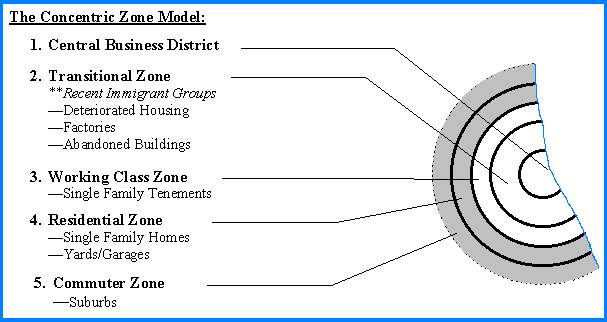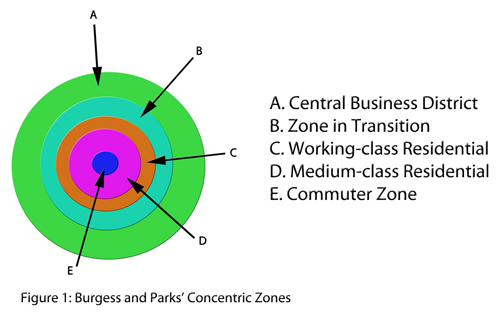Concentric zone theory, also known as the Burgess model or the Chicago School theory, is a model of urban social structure that was developed by sociologist Ernest Burgess in the 1920s. It is based on the idea that cities are organized into a series of concentric zones, with each zone representing a different social class and way of life.
According to concentric zone theory, the city is divided into five main zones. The first zone is the central business district (CBD), which is the commercial and financial hub of the city. It is typically located in the center of the city and is characterized by high-rise office buildings, department stores, and other businesses.
The second zone is the inner city, which is characterized by low-income housing, poverty, and crime. This area is often home to minority groups and immigrants who have been pushed to the outskirts of the city due to discrimination and segregation.
The third zone is the outer city, which is typically made up of middle-class neighborhoods. These neighborhoods are characterized by single-family homes, good schools, and relatively low levels of crime.
The fourth zone is the suburban fringe, which is made up of suburbs and exurbs that are located on the outskirts of the city. This area is characterized by large, single-family homes, private schools, and a lower density of population.
Finally, the fifth zone is the rural fringe, which is made up of agricultural land and small towns that are located outside of the city.
One of the key ideas of concentric zone theory is that the social and economic conditions in each of these zones are closely linked to one another. For example, the central business district is typically the most prosperous and attracts the highest income earners, while the inner city is typically the poorest and attracts the lowest income earners. Similarly, the outer city and suburban fringe are typically home to the middle class, while the rural fringe is typically home to lower-income agricultural workers.
While concentric zone theory has been influential in the field of urban sociology, it has also been subject to criticism. Some critics argue that the model is overly simplistic and does not adequately capture the complexity of urban social structure. Others have pointed out that cities are not always organized in a series of concentric zones and that other factors, such as race and ethnicity, can also play a role in shaping urban social structure.
Despite these criticisms, concentric zone theory remains an important framework for understanding the social and economic dynamics of cities and how they are shaped by the interactions between different social groups. It provides a useful way of thinking about how cities are organized and how different groups within them are impacted by the social, economic, and cultural forces that shape urban life.







